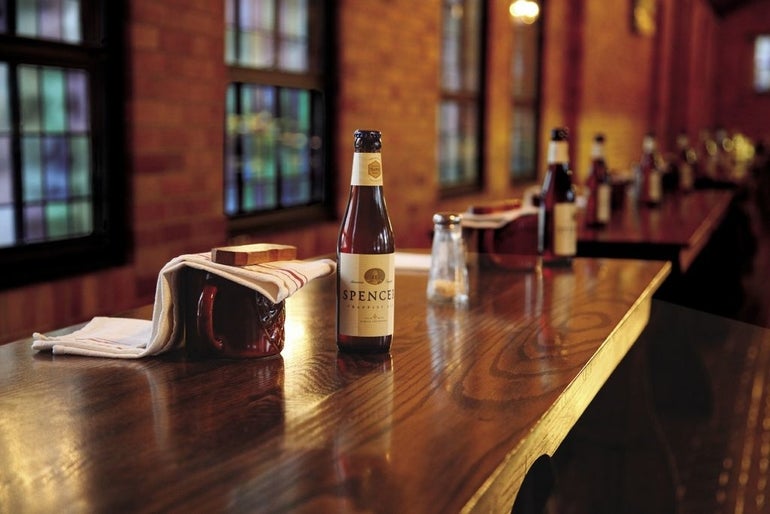Despite owning the first brewery in New England’s second largest city, Ben Roeschstarted small.
Wormtown Brewery Co. occupied just 2,000 square feet in a former ice cream parlor on Worcester’s Park Avenue when it opened in March 2010. And the brewery was equipped to produce just 1,000 barrels (or 31,000 gallons) of beer annually.
Within nine months, Wormtown’s production facilities were unable to satiate demand, Roesch said. And even boosting the annual production capacity to 3,000 barrels — the most the facility could handle — wasn’t enough.
Just four years after cutting the ribbon, Wormtown Brewery needed a new home.
“We were very surprised to run out of space so quickly,” Roesch said.
Craft breweries are becoming bigger and more pervasive across both Central Massachusetts and the country, producing more full-flavored beer than ever before.
Central Massachusetts was home to just four breweries before Wormtown opened. Today, 12 small-scale brewers call the region home, with two more on the way this summer.
The number of operational craft breweries nationwide grew from 1,970 in 2011 to 2,768 in 2013, with the volume of beer sold over that period rising 36 percent, according to the Brewers Association (BA), an industry trade group. In Massachusetts, the number of craft breweries has more than doubled, from less than 30 in 2009 to roughly 60 today, according to Rob Martin, president of the state Brewers Guild.
“As smaller breweries, we have the ability to create flavor profiles that are appealing to a much smaller group,” Martin said. “With the big breweries, it’s all sort of the same.”
Large-scale breweries are struggling against competition from within the industry and the wine and spirits sector. Overall beer consumption fell 2 percent in 2013, with macrobreweries losing 3.4 percent of their market share to craft brews since 2009, the BA found.
In 1978, America had just 89 breweries, the lowest in modern history. But that was about to change thanks to the legalization of home brewing, said Bart Watson, a BA staff economist.
Sam Adams and Harpoon were two of the nation’s first craft breweries, Martin said, getting their starts in 1984 and 1986, respectively. Microbrewing came to Central Massachusetts in 1994 when Wachusett set up shop in Westminster.
But progress was initially slow, Martin said, as beer drinkers were set in their ways and used to the uniform, minimal flavor of macrobrews.
“We had to take something out of their refrigerator that they were used to buying and replace it with our product,” he said.
The tide turned, though, as millennials (born around 1980 or later) started to reach drinking age. Watson said millennials strongly prefer a fully-flavored beer and like to support local, independent businesses.
Craft beers also appeal more to women, Watson said, and are easier to pair with food than macrobrews.
Growing public familiarity with craft beers has made it easier for local brewers to thrive.
Krestschmann Brewing Co. plans to move this summer from a 740-square-foot building on the outskirts of Webster to a larger space downtown, while Wormtown expects the production line at its new 10,000-square-foot space on Shrewsbury Street to roll out its first beer by Sept. 1.
Wormtown’s capacity limit in the new building will soar all the way up to 30,000 barrels annually, though Roesch indicated the brewery plans to produce just 6,000 each year for now. He said the new site will also make it possible for Wormtown to, for a limited time, offer brewery tours and operate a tasting room with beer and merchandise.
“Beer tourism is very hot right now,” he said.
In addition, it will become much easier for Wormtown to produce six packs, thanks to a new bottling line, which will be able to generate 5,000 cans per hour. In the current facility, four employees working together can, by hand, bottle roughly 180 per hour, Roesch said.
New offerings are on the way as well, with Medusa Brewing Co. planning to open a brewpub this summer with more than 80 seats in downtown Hudson, while 3Cross Brewing Co. puts the final touches on a 5,500-square-foot brewery on Cambridge Street in Worcester, slated to open in early summer.
“The explosion of craft beer in the public eye during the last couple of years made me realize that now is the time,” 3Cross Brewing owner Dave Howland said in an email. “There’s a strong craft beer culture here in Worcester, but a definite lack of breweries.”
Howland said he began home brewing in 2009 and fell in love with its technical aspects due to his engineering background. He plans to continue using home-brewing equipment and make just 150 to 200 barrels in his first year, which will be served in a taproom for 120 people open only on Saturdays.
The most recent brewery debut came courtesy of the monks at Saint Joseph’s Abbey in Spencer, who opened the first Trappist brewery in North America at the beginning of this year.
The 63 monks faced a bleak economic future as expenditures threatened to exceed revenue. Brewery spokeswoman Mary Jeffcoat said traditional income sources — such as heavy agriculture — were out of the picture due to the monks’ advanced age. But one of the monks had experience and interest in brewing, and eventually convinced his brethren to establish an authentic Trappist brewery.
Despite plans to brew just 4,000 barrels this year, and a distribution network limited to Massachusetts, the Spencer Brewery has attracted national and international headlines since its opening, Jeffcoat said, and demand has greatly outpaced supply.
But that isn’t too much of a surprise.
Before undertaking the project, the monks gathered data for two years, visited nine Trappist breweries in Europe, gathered advice and sampled some of the world’s finest beer.
“I haven’t heard them saying this was a risk,” Jeffcoat said, “because they did their homework.” n

